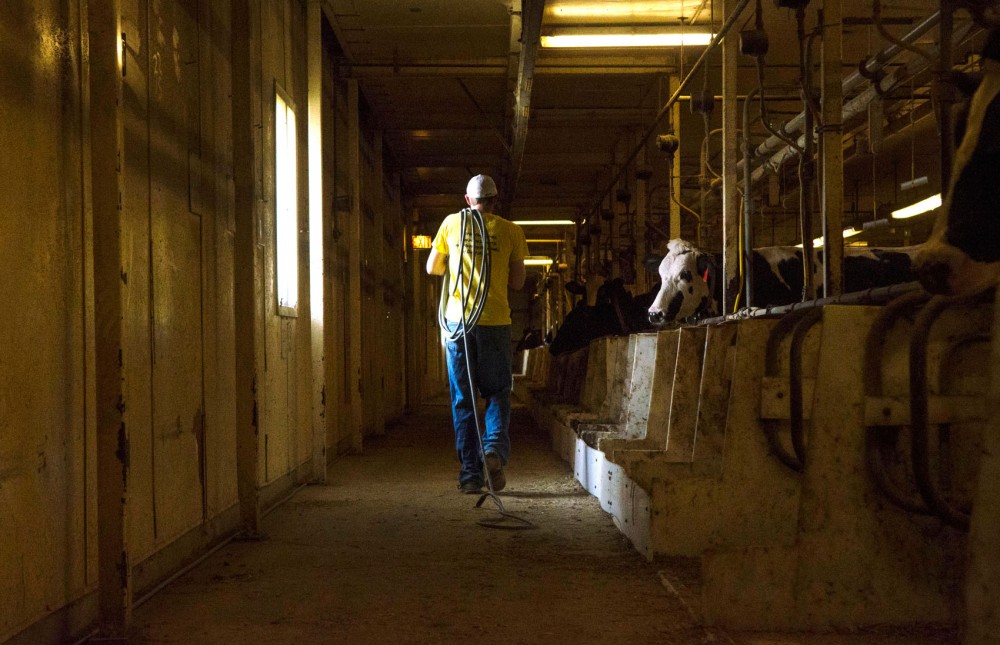In the University of Minnesota dairy barns on the St. Paul campus, it’s almost as hot inside as it is outside.
With 106 cows and a few calves to milk, feed and clean up after every day, assistant barn manager Nate McDonald said working in and around the barns — which are part of the Midwest Dairy Foods Research Center — is heat- and labor-intensive.
“You’ve got to suck it up and drink a lot of water,” he said.
McDonald is one of many University employees working with rising temperatures outside this summer. Some areas of the University, including Facilities Management, offer heat safety training to employees, but no institution-wide protocol exists.
Doing physical work outside in high temperatures and humidity puts workers at risk for heat stress, heat exhaustion and heat stroke — a serious condition that occurs when the body can’t regulate its temperature.
McDonald and the barn manager make sure their employees get breaks from being out in the sun and drink plenty of liquids to stay safe on hot days, he said. They also try to do the most intense labor, like shoveling, themselves.
McDonald, who works outside year-round, said he prefers winter because cows can get heat-stressed in summer, too.
“Cows do better in winter; we do better in winter,” he said.
Though University Landcare gardener Steve Chichester has worked outside for six years building irrigation systems, he said he’s never seen anyone get heat stroke.
To avoid heat-related injuries, Chichester said his team does more difficult jobs in the morning when it’s cooler.
Genetics and cell biology junior Joey Krenz drives a golf cart around campus for his summer Landcare job, which he said is a nice change from working in a lab during the school year.
Krenz stays cool on the job by sprinkling water on himself as he waters flowers.
“It’s not as bad as you’d think,” he said.
To stay hydrated, Krenz said he fills a thermos with coffee and drinks it until his first break at 9 a.m., when he fills the thermos with water for the rest of the day.
Working in the heat has been an “adjustment,” said architecture sophomore Nathan Tripp, who started working for Ladcare at the beginning of the summer.
To avoid overheating, Tripp said he orders his daily tasks depending on the temperature. He’ll do work requiring hot equipment like leaf blowers during the cooler part of the day and save smaller jobs like pruning for the afternoon.
“It’s just a lot of common sense,” he said.
During the summer, Landcare supervisors hold weekly “toolbox talks” and in-depth safety meetings every other month to remind employees of outdoor risks and ways to avoid injury.
In addition to drinking lots of water, employees can stay hydrated by avoiding caffeine and large amounts of sugar, said Landcare supervisor Jason Grode.
Not drinking alcohol the night before work can also decrease the risk of heat illnesses, he said.
In the last eight years, Grode said Landcare hasn’t had any reports of heat-related injuries.
Landcare work crews are given the option of starting an hour earlier on particularly hot days, which he said is healthy for employees and the landscape. Laying turf, for example, is more effective when the ground is cool.
“It’s kind of a win-win situation when we can come in early,” Grode said.
Other risks of working outside
As a graduate student in the late 1970s, horticultural science professor Tom Michaels said he really enjoyed doing research outside.
“Back then, less was known [about skin cancer], and one of the great things about this field work was you could get a fantastic tan,” he said. “Now, I’m the guy with the big floppy hat.”
Working outside in the summer to plant beans for his research, Michaels said he worries more about the sun than the heat and reminds his research crew to wear long sleeves and to put on sunscreen.
Bud Markhart, a University professor who died last year from melanoma complications, is a constant reminder of the importance of staying safe in the sun, Michaels said.
Markhart always reminded faculty members to take care of themselves.
“Across the department, that had quite a big impact,” Michaels said. “He certainly made us really aware of covering up.”
Although researchers who spend long hours outside have no uniform safety training, Michaels said he might look into it because having another precautionary reminder can only help.
“Even though we practice common sense,” he said, “it’s easy to do dumb things.”


